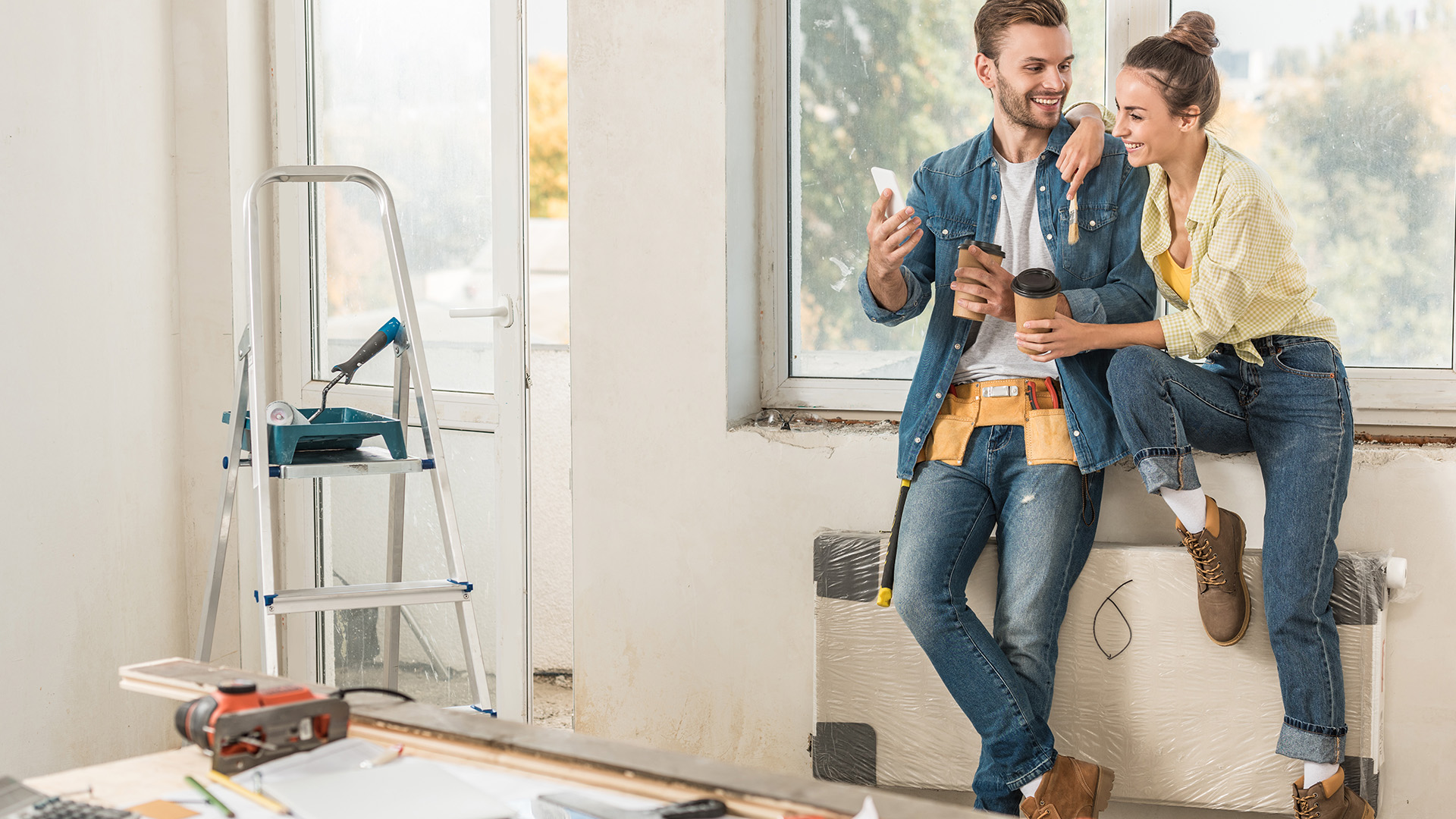Unleash Your Inner Painter: Expert Tips for a Flawless Finish
Welcome to the Overland Park Home Pros Blog, where we bring you the most innovative and reliable home improvement advice. Today, we’re delving into the world of painting – a seemingly simple task that can transform your home’s aesthetics. While many homeowners are familiar with the basics of painting, we’re here to share some lesser-known but incredibly valuable tips that can take your painting projects to the next level. Whether you’re looking to refresh a single room or overhaul your entire home’s color scheme, these insights will help you achieve professional results with ease.
The Science of Color Selection
Beyond Aesthetics: The Psychology of Color
Choosing the right color for your home goes beyond mere aesthetics. Colors have a profound impact on our emotions and can influence the atmosphere of a space. Here’s a quick guide to understanding the psychology of colors:
- Blue: Calming and serene, ideal for bedrooms and bathrooms.
- Yellow: Energizing and uplifting, perfect for kitchens and living rooms.
- Green: Balancing and refreshing, suitable for any room.
- Red: Stimulating and passionate, best used as an accent color.
- Gray: Neutral and sophisticated, great for modern and minimalist spaces.
The Importance of Lighting
Lighting can dramatically affect how a paint color looks in your home. Before committing to a color, observe how it appears at different times of the day and under various lighting conditions. Natural light, incandescent bulbs, and fluorescent lighting can all change the perception of color, so it’s crucial to test samples on your walls and see how they respond to your specific lighting environment.
Preparation: The Key to a Perfect Finish
The Power of a Clean Surface
One of the most overlooked steps in painting is surface preparation. A clean, smooth surface is essential for achieving a flawless finish. Here’s how to ensure your walls are ready for paint:
- Cleaning: Use a mild detergent to remove dirt, grease, and grime. For tougher stains, consider a trisodium phosphate (TSP) solution.
- Sanding: Lightly sand the walls to create a smooth surface. This also helps the paint adhere better. Don’t forget to wipe away dust with a damp cloth afterward.
- Repairing: Fill any holes, cracks, or imperfections with spackle or joint compound. Once dry, sand the repaired areas until smooth.
Priming for Success
Primer is a crucial step that many DIY painters skip, but it can make a significant difference in the final outcome. Primer helps seal the surface, providing a uniform base for the paint to adhere to. It’s especially important when painting over dark colors, stains, or new drywall. Choose a primer that’s suitable for your specific needs – there are primers designed for various surfaces and situations, such as stain-blocking, bonding, and high-humidity areas.
Techniques for a Professional Finish
Mastering the Art of Cutting In
Cutting in is the technique of painting the edges and corners of a room with a brush before using a roller on the larger surfaces. This step requires a steady hand and some practice, but it’s essential for achieving clean, sharp lines. Here are some tips to perfect your cutting-in technique:
- Use the Right Brush: A high-quality, angled sash brush is ideal for cutting in. It provides better control and precision.
- Load the Brush Properly: Dip the brush about one-third of the way into the paint, then tap off excess paint. This helps prevent drips and ensures even coverage.
- Steady Your Hand: Use your other hand to support your painting hand, and take your time to ensure clean, straight lines.
The W Technique for Rolling
The W technique is a tried-and-true method for rolling paint onto large surfaces. It helps distribute the paint evenly and reduces the risk of roller marks. Here’s how to do it:
- Load the Roller: Dip the roller into the paint tray, then roll it back and forth to evenly distribute the paint.
- Create a W Shape: Start at the top corner of the wall and roll in a W pattern. Fill in the gaps without lifting the roller, maintaining a wet edge to prevent lap marks.
- Overlap Strokes: Overlap each stroke slightly to ensure even coverage and a smooth finish.
Advanced Tips for a Flawless Paint Job
Managing Humidity and Temperature
Humidity and temperature can affect the drying time and finish of your paint job. For the best results, paint in a controlled environment where the temperature is between 50°F and 85°F, and the humidity is below 50%. High humidity can cause paint to dry too slowly, leading to drips and an uneven finish. Low temperatures can also slow down drying time and affect the paint’s ability to adhere properly.
Using Paint Additives
Paint additives can enhance the performance and finish of your paint. Here are a few to consider:
- Flow Improvers: These help reduce brush and roller marks, creating a smoother finish. They’re especially useful when working in hot or dry conditions.
- Mildewcides: Add these to your paint for areas prone to moisture, such as bathrooms and kitchens. They help prevent mold and mildew growth.
- Texture Additives: If you want to add a unique texture to your walls, consider using texture additives. They come in various forms, such as sand, stone, and metallic particles.
Creative Painting Techniques
Accent Walls: Making a Statement
Accent walls are a fantastic way to add drama and personality to a room without overwhelming the space. Choose a bold color or a unique pattern to create a focal point. Here are some creative ideas for accent walls:
- Stripes: Vertical or horizontal stripes can add height or width to a room, creating a visually appealing effect.
- Ombre: Blend two or more colors to create a gradient effect that adds depth and interest.
- Geometric Patterns: Use painter’s tape to create intricate geometric designs for a modern, eye-catching look.
Faux Finishes: Adding Texture and Depth
Faux finishes can mimic the look of various materials, such as marble, wood, or concrete, adding texture and depth to your walls. Here are a few popular techniques:
- Sponging: Use a natural sea sponge to apply glaze or paint in a stippling pattern, creating a soft, textured look.
- Rag Rolling: Roll a rag dipped in glaze or paint over the wall to create a subtle, marbled effect.
- Brushed Pearl: Apply a pearlescent glaze with a brush in a crisscross pattern for a sophisticated, shimmery finish.
Safety First: Essential Precautions
Ventilation and Protective Gear
Painting can expose you to fumes and chemicals, so it’s essential to take safety precautions. Ensure your workspace is well-ventilated by opening windows and using fans. Wear protective gear, such as gloves, goggles, and a respirator mask, to protect your skin, eyes, and lungs.
Safe Disposal of Paint
Improper disposal of paint can harm the environment. Check with your local waste management facility for guidelines on how to dispose of paint safely. Many areas offer special collection events for hazardous materials, including paint and solvents.
At Overland Park Home Pros, we are passionate about helping homeowners achieve professional-quality results with their painting projects. By sharing these lesser-known but valuable tips, we hope to inspire you to take your painting skills to the next level. Whether you’re refreshing a single room or transforming your entire home, these insights will help you achieve a flawless finish that enhances the beauty and value of your living spaces.
Explore our blog for more expert advice, and don’t hesitate to contact us for any of your home improvement needs. Together, we can transform your house into the home of your dreams, ensuring it remains a sanctuary of comfort, safety, and joy for years to come.
Stay tuned to the Overland Park Home Pros Blog for more valuable content that helps you make the most of your living space. Happy painting!

